A Comparative Study on the Finite Element Analysis of Multilayered Honeycomb Composite Materials for Aerospace Structures
Abstract
1. Introduction
2. Materials and Methods
2.1. Material Design and Description
2.2. Computation of Equivalent Orthotropic Material Data for the Honeycomb Core
- 1.
- Transverse elastic modulus for the cell wall:
- —longitudinal elastic modulus of the material;
- —Poisson’s ratio.
- 2.
- Modulus of elasticity of orthotropic honeycomb core in x1 direction:
- 3.
- Modulus of elasticity of orthotropic honeycomb core in x2 direction:
- 4.
- In-plane Poisson’s ratio:
- 5.
- Transverse shear modulus on x1-x2 plane:
- 6.
- Elastic modulus in out-of-plane direction:
- 7.
- Out-of-plane Poisson’s ratios:
- 8.
- x1-x3 plane shear modulus:
- 9.
- x2-x3 plane shear modulus:
2.3. Experimental Investigation of the Honeycomb Structure
2.4. Finite Element Models of the Experimental Setup
2.5. Loading Conditions
2.6. Numerical Results
3. A Practical Case Analysis for Multilayered Honeycomb Composite Materials
- static loading given by a weight, for example, in aircraft floor loading;
- dynamic pressure acting on structure, given by the vicinity of a moving fluid or aerodynamic forces;
- static pressure given by a stationary fluid, such as tank pressure loads.
3.1. Finite Element Model Description
3.2. Loading Conditions
3.3. Simulation Results
4. Conclusions
- the two FE models offer comparable results when it comes to predicting the compressive behavior under quasi-static loads, each of them presenting different advantages and disadvantages in terms of execution and precision;
- a more detailed analysis, such as the one performed on the first model, can offer better results with reference to local stiffness evaluation or stability phenomena—with differences of less than 11% compared to experimental deflection data. On the other hand, this method is less practical for large structural applications since the modelling complexity is increased fivefold over the equivalent one;
- in contrast, the simplified model, as seen from the results, is better suited for modelling complex assemblies or parts, where a global behavior analysis is more desired. This method relies on an appropriate estimation of the equivalent mechanical orthotropic properties for the composite material and can offer results close to those of the detailed model, up to 9% difference, with a reduction of up to 80% of computational time. While this second model can give reliable information about structural integrity, it cannot truly predict local effects;
- numerical results were validated successfully with experimental data obtained from laboratory tests, displaying a suitable accuracy for the linear elastic domain, before the material’s staggered failure. A comparison between the two previous modelling techniques was also made considering the minimum compressive principal strain that was registered, and a good correlation was found for the two approaches.
Author Contributions
Funding
Institutional Review Board Statement
Informed Consent Statement
Data Availability Statement
Conflicts of Interest
References
- Fangueiro, R.; Rana, S. Advanced Composite Materials for Aerospace Engineering: Processing, Properties and Applications; Elsevier Science, Woodhead Publishing: Duxford, UK, 2016. [Google Scholar]
- Kausar, A.; Ahmad, I.; Rakha, S.A.; Eisa, M.H.; Diallo, A. State-of-the-Art of Sandwich Composite Structures: Manufacturing—To—High Performance Applications. J. Compos. Sci. 2023, 7, 102. [Google Scholar] [CrossRef]
- Ma, W.; Elkin, R. Sandwich Structural Composites: Theory and Practice; CRC Press: Boca Raton, FL, USA, 2021. [Google Scholar]
- Hadar, A. Layered Composite Structures. Methods, Algorithms and Calculation Programs; A.G.I.R.: Bucharest, Romania, 2002. (In Romanian) [Google Scholar]
- Gong, X. Investigation of Different Geometric Structure Parameters for Honeycomb Textile Composites on Their Mechanical Performance. Ph.D. Thesis, University of Manchester, Manchester, UK, 2011. [Google Scholar]
- Federal Aviation Administration. Aviation Maintenance Technician Handbook-Airframe Volume 2. Available online: https://www.faa.gov/handbooksmanuals/aviation/aviation-maintenance-technician-handbook-airframe-volume-2 (accessed on 12 November 2024).
- Asprone, D.; Auricchio, F.; Menna, C.; Morganti, S.; Prota, A.; Reali, A. Statistical finite element analysis of the buckling behavior of honeycomb structures. Compos. Struct. 2013, 105, 240–255. [Google Scholar] [CrossRef]
- Altenbach, H.; Altenbach, J.; Kissing, W. Mechanics of Composite Structural Elements; Springer Nature: Singapore, 2018. [Google Scholar]
- Teotia, M.; Soni, R.K. Applications of finite element modelling in failure analysis of laminated glass composites: A review. Eng. Fail. Anal. 2018, 94, 412–437. [Google Scholar] [CrossRef]
- Castanie, B.; Bouvet, C.; Ginot, M. Review of composite sandwich structure in aeronautic applications. Compos. Part C Open Access 2020, 1, 100004. [Google Scholar] [CrossRef]
- Birman, V.; Kardomateas, G.A. Review of current trends in research and applications of sandwich structures. Compos. Part B Eng. 2018, 142, 221–240. [Google Scholar] [CrossRef]
- Longquan, L.; Hai, W.; Zhongwei, G. Experimental and numerical study on the mechanical response of Nomex honeycomb core under transverse loading. Compos. Struct. 2015, 121, 304–314. [Google Scholar] [CrossRef]
- Russell, B.P.; Deshpande, V.S.; Wadley, H.N.G. Quasistatic Deformation and Failure Modes of Composite Square Honeycombs. J. Mech. Mater. Struct. 2008, 3, 1315–1340. [Google Scholar] [CrossRef]
- Han, X.; Cai, H.; Sun, J.; Wei, Z.; Huang, Y.; Wang, A. Numerical Studies on Failure Mechanisms of All-Composite Sandwich Structure with Honeycomb Core under Compression and Impact Loading Conditions. Polymers 2022, 14, 4047. [Google Scholar] [CrossRef]
- Priyadarsini, M.; Kiran Kumar, N.; Yeshwanth Kumar, G.; Majjiga, B.; Ganaparthy, P. Review on glass fiber reinforced polymer composites. Mater. Today Proc. 2021, 43, 314–319. [Google Scholar] [CrossRef]
- Pandu, P.A.; Sawanti, D.A. Experimental evaluation and analysis of Glass Fiber Reinforced Composite under mechanical loading by using FEA software. Int. J. Eng. Res. Technol. 2017, 10, 682–685. [Google Scholar]
- Steenackers, G.; Peeters, J.; Ribbens, B. Development of an Equivalent Composite Honeycomb Model: A Finite Element Study. Appl. Compos. Mater. 2016, 23, 1177–1194. [Google Scholar] [CrossRef]
- Tasneem, S. Fibers used for high-performance apparel. In High-Performance Apparel; Woodhead Publishing: Duxford, UK, 2018; pp. 7–32. [Google Scholar] [CrossRef]
- DuPont™ Nomex® N301 Nomex® Aramid Staple Fiber. Available online: https://www.dupont.com/brands/nomex.html (accessed on 10 February 2024).
- Pach, J.; Wróblewski, R.; Muszyński, B. Comparative Analysis of Sandwich Composites with Balsa, Rohacell®, and Nomex® Cores for Aerospace Applications. Materials 2025, 18, 1126. [Google Scholar] [CrossRef] [PubMed]
- Aliad, I.; Jung, J. Mathematical Models for in Plane Moduli of Honeycomb Structures—A Review. Res. J. Appl. Sci. Eng. Technol. 2014, 3, 581–592. [Google Scholar] [CrossRef]
- Galehdari, S.A.; Kadkhodayan, M.; Hadidi-Moud, S. Analytical, experimental and numerical study of a graded honeycomb structure under in-plane impact load with low velocity. Int. J. Crashworthiness 2015, 20, 387–400. [Google Scholar] [CrossRef]
- Wenguang, M.; Russell, E. Sandwich Structural Composites Theory and Practice, 1st ed.; CRC Press: Boca Raton, FL, USA, 2021. [Google Scholar]
- Lee, I.T.; Shi, Y.; Afsar, A.M.; Ochi, Y.; Bae, S.I.; Song, J.I. Low Velocity Impact of Aluminium Honeycomb Structures. Adv. Compos. Mater. 2010, 19, 19–39. [Google Scholar] [CrossRef]
- Zheng, X.; He, B.; Zou, Y.; Yang, Q.; Cao, Y.; Li, Z.; Han, Y. Experiment and Numerical Simulation on Damage Behavior of Honeycomb Sandwich Composites under Low-Energy Impact. Aerospace 2023, 10, 756. [Google Scholar] [CrossRef]
- Falaschetti, M.P.; Semprucci, F.; Birnie Hernández, J.; Troiani, E. Experimental and Numerical Assessment of Crashworthiness Properties of Composite Materials: A Review. Aerospace 2025, 12, 122. [Google Scholar] [CrossRef]
- Al Ali, A.; Arhore, E.; Ghasemnejad, H.; Yasaee, M. Experimental and numerical investigation of multi-layered honeycomb sandwich composites for impact mechanics applications. Results Eng. 2024, 21, 101817. [Google Scholar] [CrossRef]
- Tserpes, K.; Sioutis, I. Advances in Composite Materials for Space Applications: A Comprehensive Literature Review. Aerospace 2025, 12, 215. [Google Scholar] [CrossRef]
- Severson, P.; Lutz, A.; Elhajjar, R. Pull-Through Behavior of Novel Additively Manufactured Sandwich Composite Inserts. Materials 2024, 17, 1884. [Google Scholar] [CrossRef]
- Ince, J.C.; Peerzada, M.; Mathews, L.D. Overview of emerging hybrid and composite materials for space applications. Adv. Compos. Hybrid. Mater. 2023, 6, 130. [Google Scholar] [CrossRef]
- Arbaoui, J.; Schmitt, Y.; Pierrot, J.-L.; Royer, F.-X. Numerical simulation and experimental bending behavior of multilayered sandwich structures. J. Theor. Appl. Mech. 2014, 52, 431–442. [Google Scholar]
- Seemann, R. A Virtual Testing Approach for Honeycomb Sandwich Panel Joints in Aircraft Interior; Institut für Produktentwicklung und Konstruktionstechnik, Springer Vieweg: Hamburg, Germany, 2020. [Google Scholar]
- Cormos, R. Mechanical Response Evaluation of Honeycomb Multilayered Composite Materials Subjected to Low Velocity Impact Loading. Ph.D. Thesis, University Politehnica of Bucharest, Bucharest, Romania, 2018. (In Romanian). [Google Scholar]
- Draghici, S.; Parausanu, I.; Baciu, F.; Petrescu, H.A.; Hadar, A.; Pastrama, S.D. A Comparative Experimental-Numerical Analysis on the Vibration Behaviour of a Composite Satellite Subset. Mat. Plast. 2016, 53, 585–589. [Google Scholar]
- Gibson, L.J.; Ashby, F.M. Cellular Solids Structure and Properties, 2nd ed.; Cambridge University Press: Cambridge, UK, 1999. [Google Scholar]
- Ju, J.; Summers, J.D. Design of Honeycombs for Modulus and Yield Strain in Shear. J. Eng. Mater. Technol. 2012, 134, 1–15. [Google Scholar] [CrossRef]
- Liang, S.; Chen, H.L. Investigation of the square cell honeycomb structures under axial loading. Compos. Struct. 2006, 72, 446–454. [Google Scholar] [CrossRef]
- Zhao, H. Stress Analysis of Tapered Sandwich Panels with Isotropic or Laminated Composite Facing. Ph.D. Thesis, University of Maine, Orono, ME, USA, 2002. [Google Scholar]
- Cormos, R.; Petrescu, H.-A.; Hadăr, A.; Adîr, G.M.; Gheorghiu, H. Finite Element Analysis of the Multilayered Honeycomb material Subjected to Impact Loading. Mat. Plast. 2017, 54, 180–185. [Google Scholar] [CrossRef]
- ISO 291:2008; Plastics—Standard Atmospheres for Conditioning and Testing. ISO: Geneva, Switzerland, 2008. Available online: https://www.iso.org/standard/50572.html (accessed on 6 June 2024).
- Altair HyperMesh. User Manual. 2021. Available online: https://2021.help.altair.com/2021/hwdesktop/hm/index.htm (accessed on 22 May 2024).
- Altair. Introduction to Practical Aspects of Composites with Altair OptiStruct. 2019. Ebook. Available online: https://learn.altair.com/ (accessed on 17 July 2024).
- MSC Nastran 2023.4. Linear Static Analysis User’s Guide. 2023. Available online: https://nexus.hexagon.com/documentationcenter/en-US/bundle/MSC_Nastran_2023.4_Linear_Static_Analysis_User_Guide/resource/MSC_Nastran_2023.4_Linear_Static_Analysis_User_Guide.pdf (accessed on 22 May 2024).
- MSC Patran 2023.4. User ‘s Guide. 2023. Available online: https://nexus.hexagon.com/documentationcenter/en-US/bundle/Patran_2023.4_User_Guide/resource/Patran_2023.4_User_Guide.pdf (accessed on 22 May 2024).
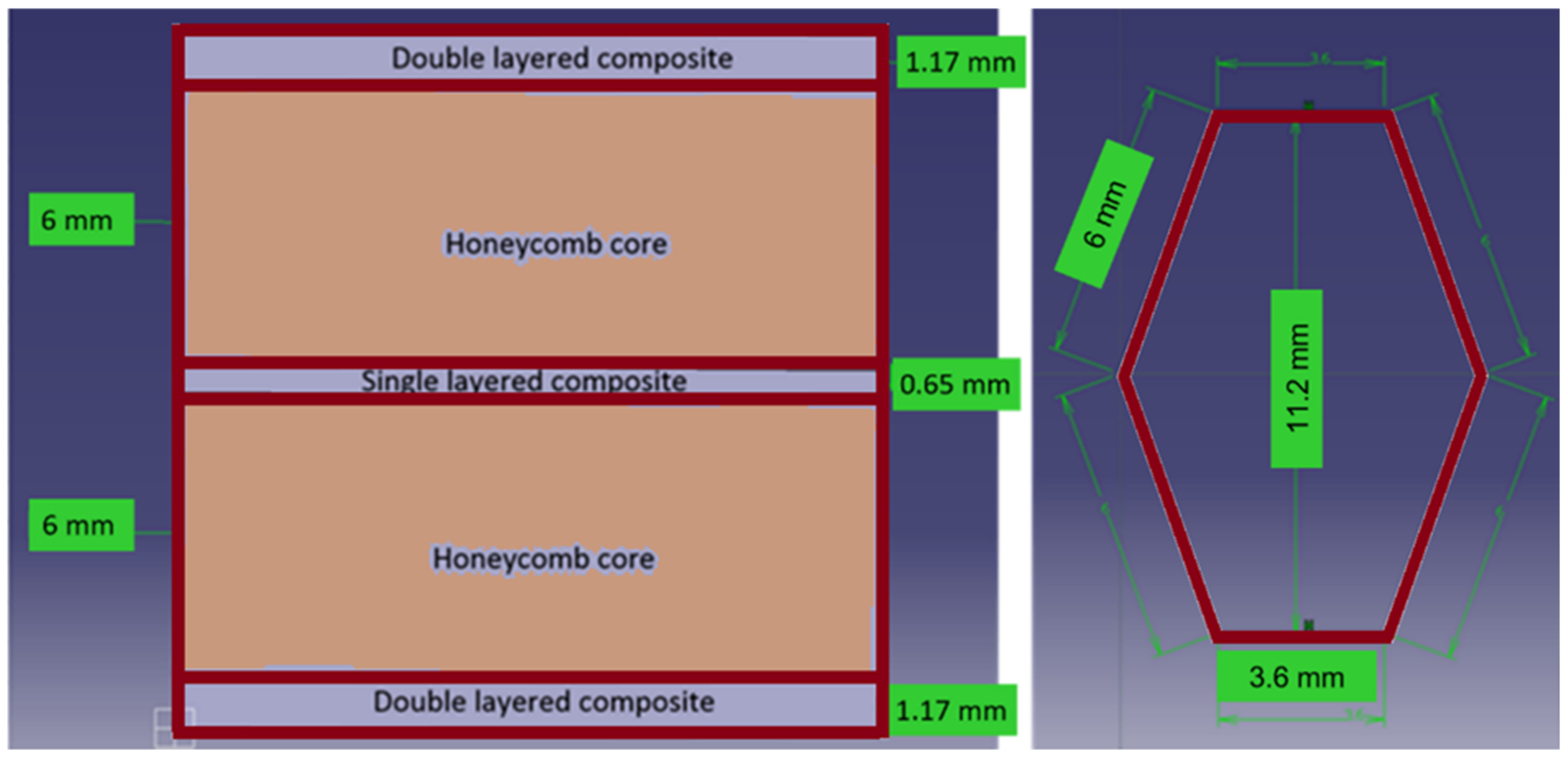
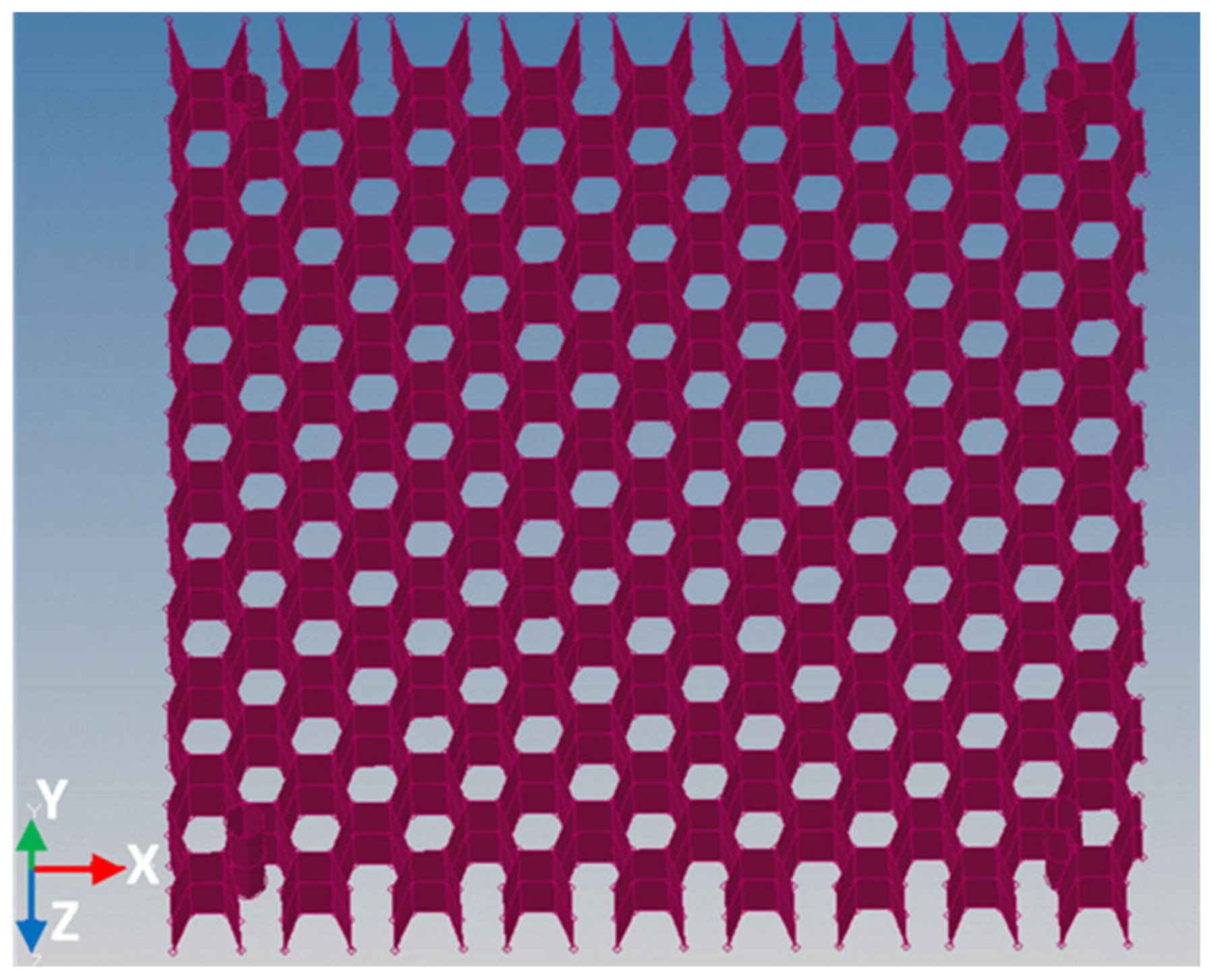

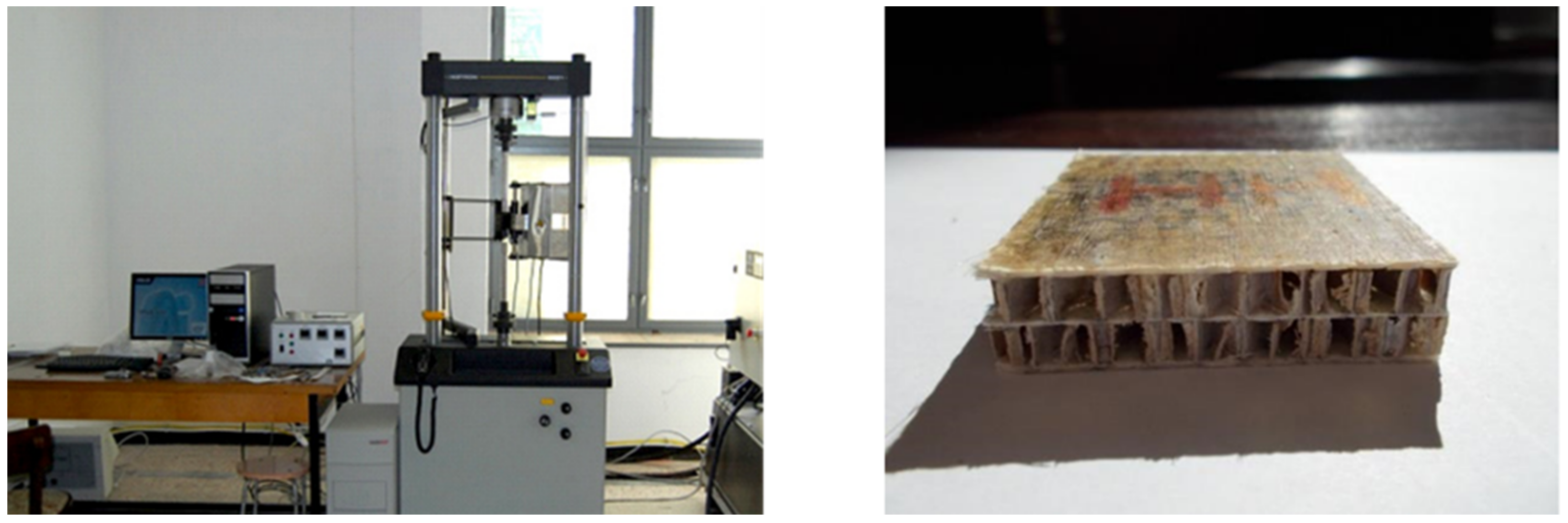

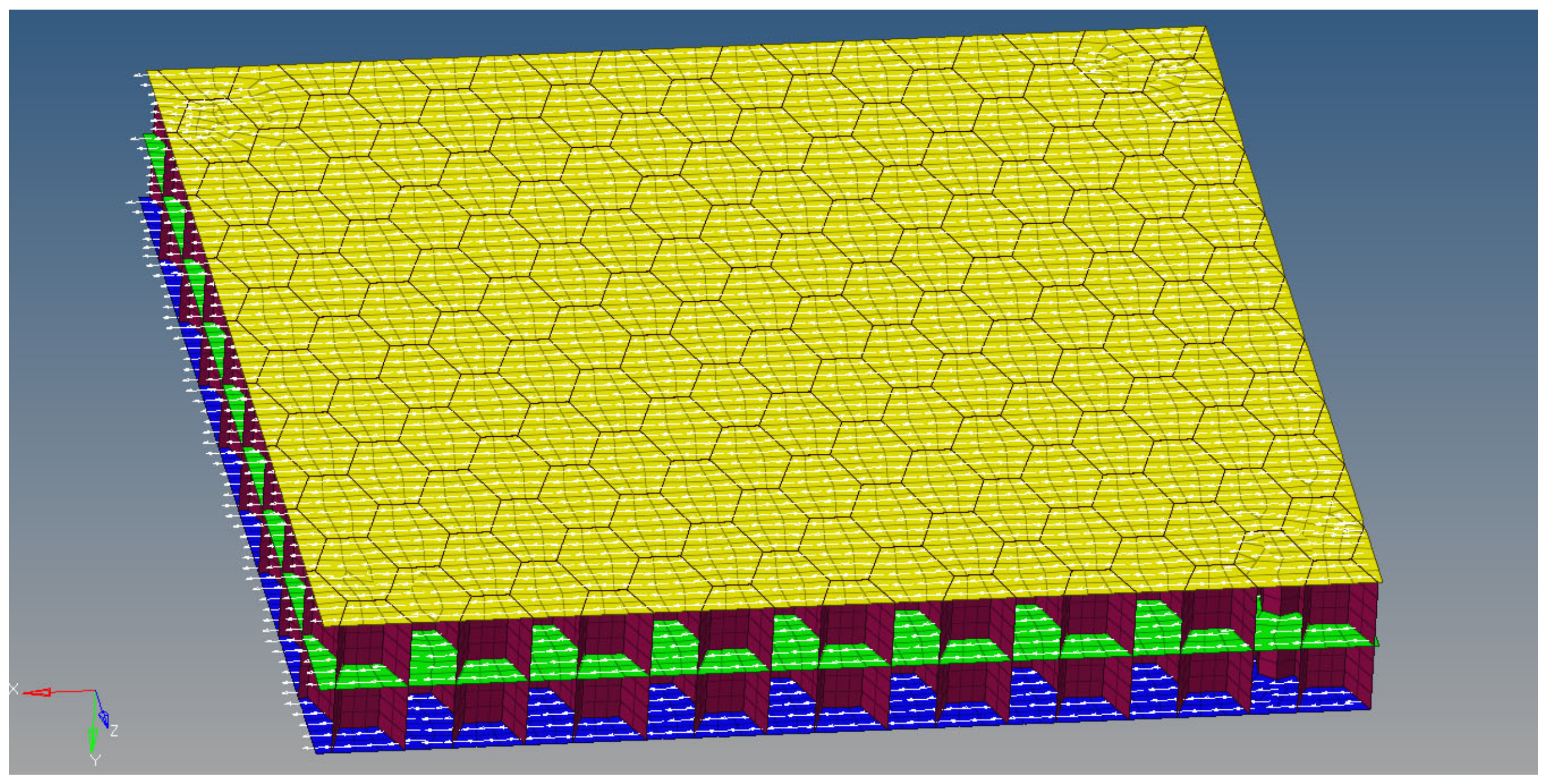
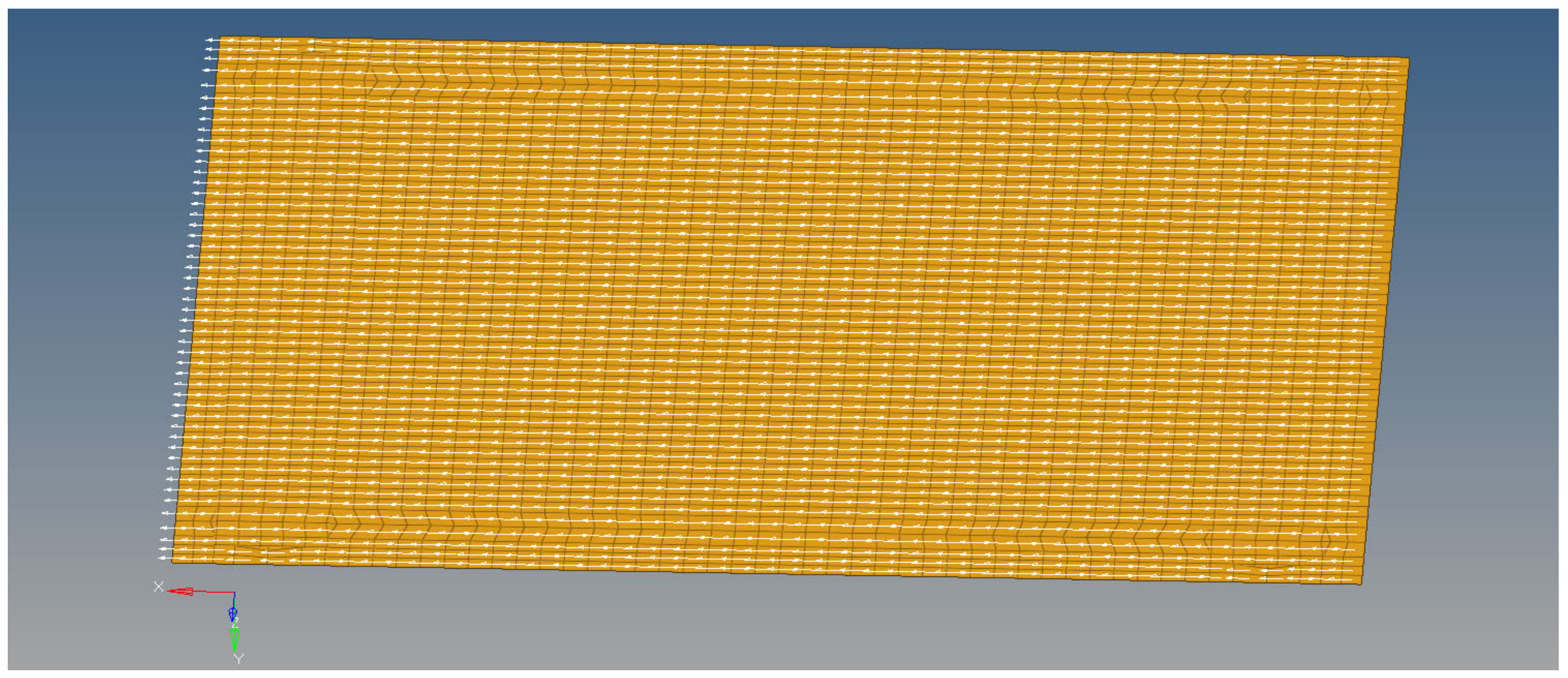



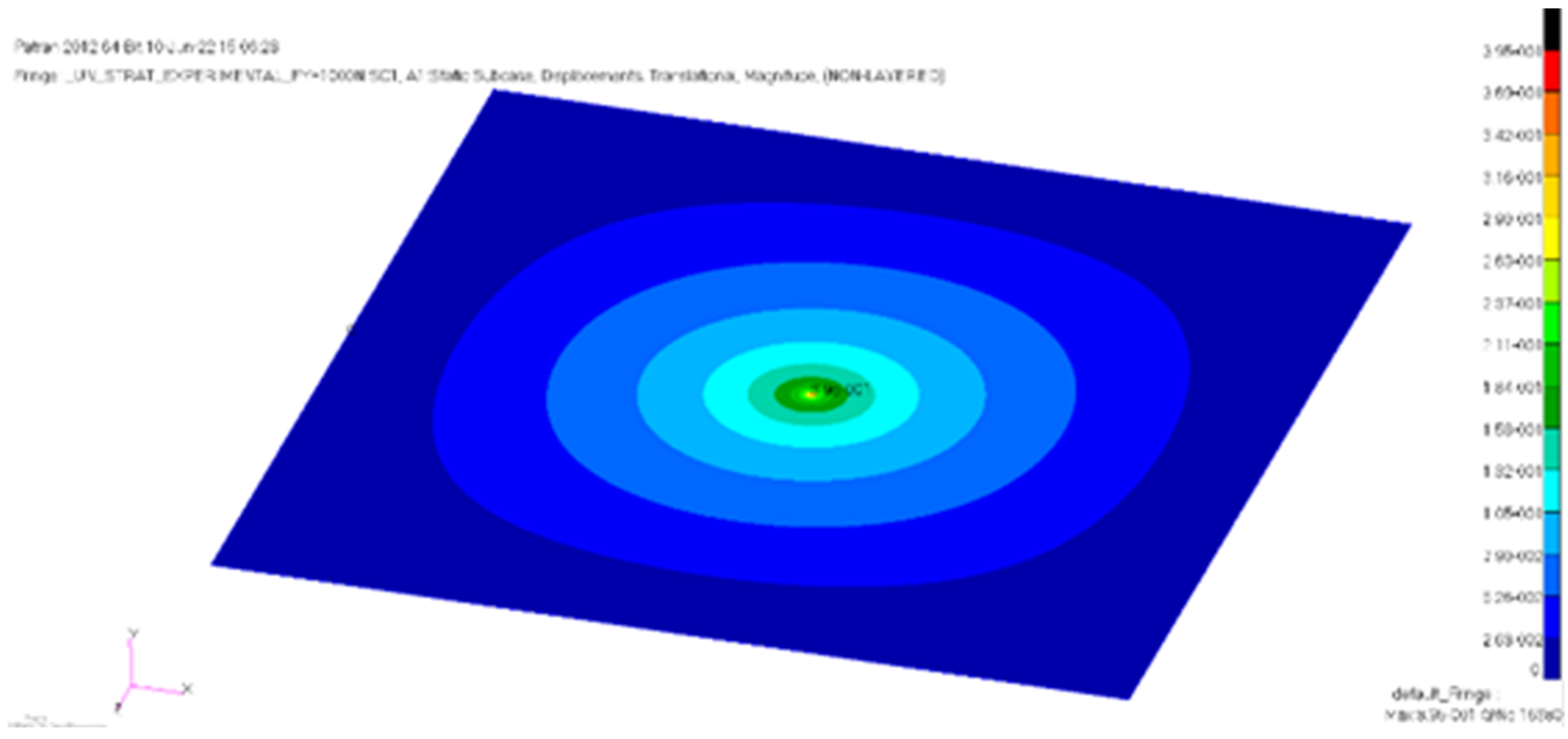
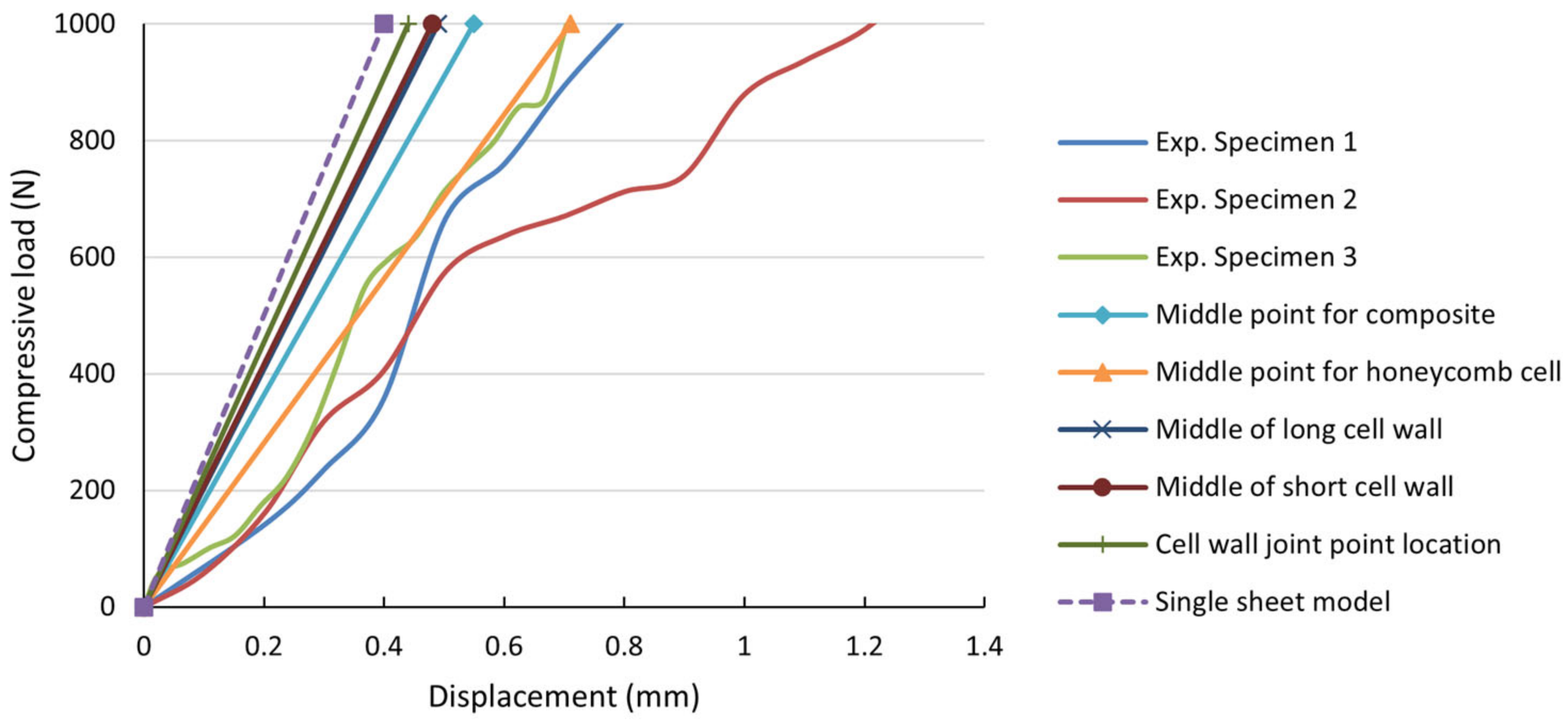
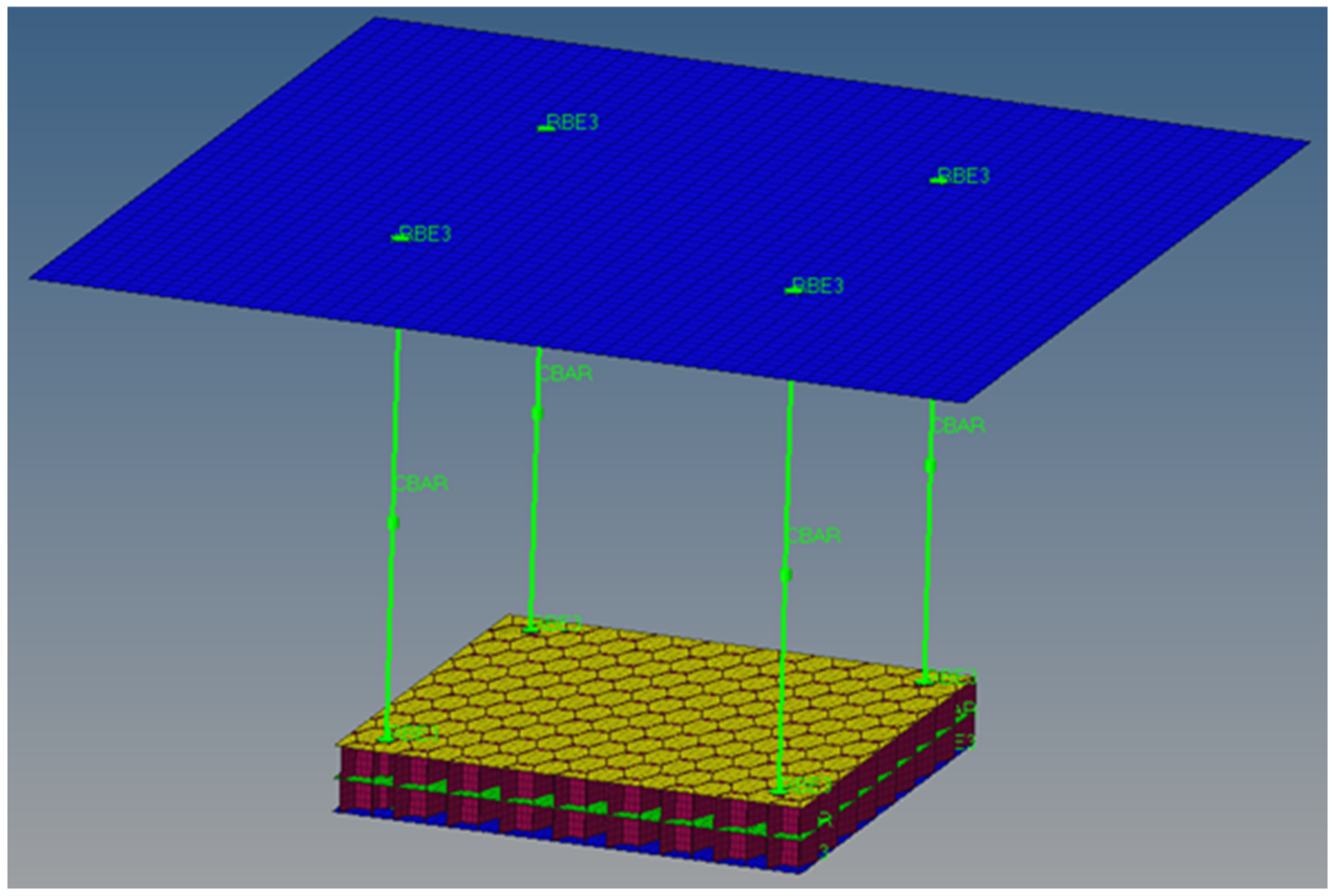
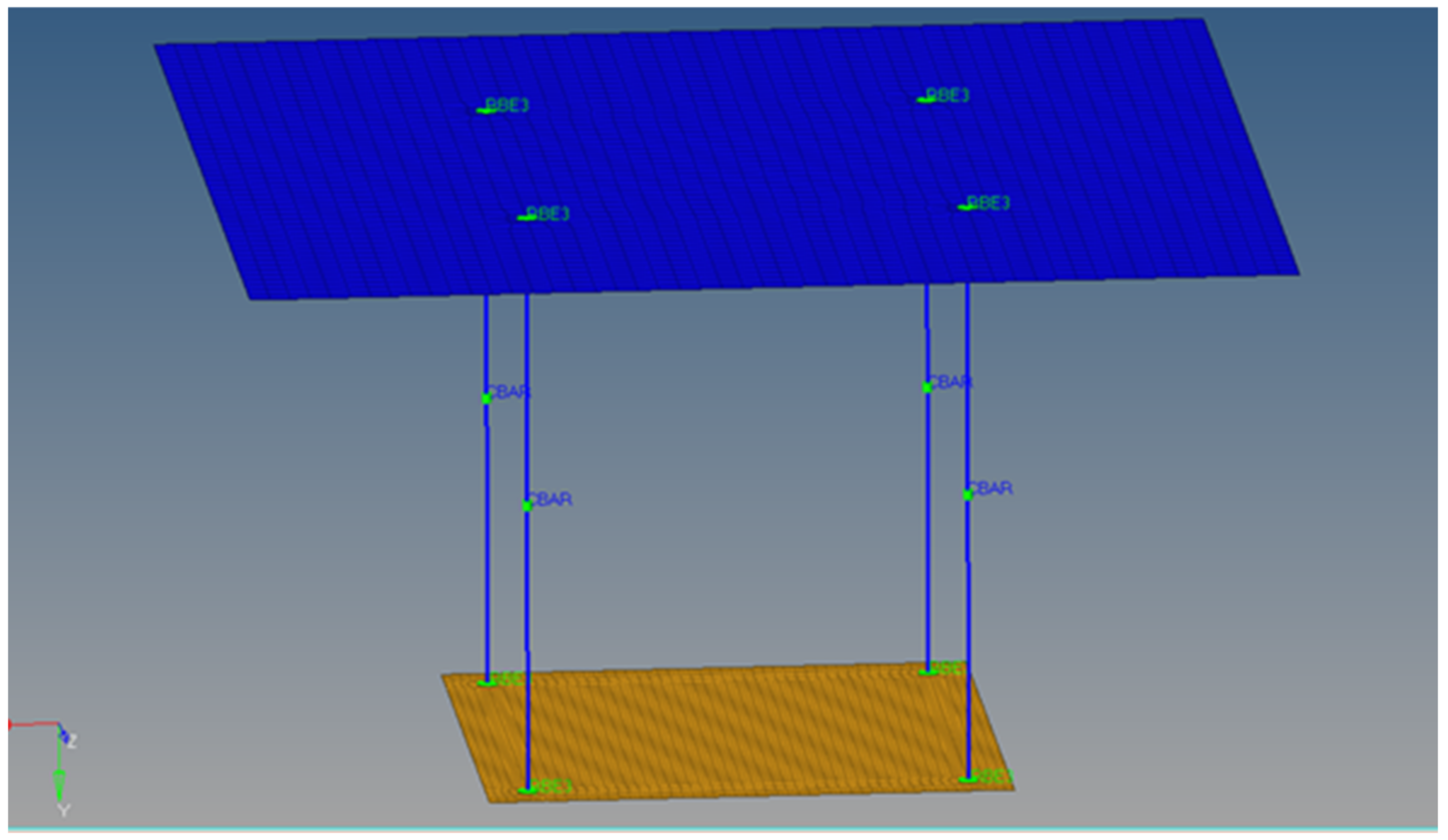


| Characteristics | Value | Unit of Measurement |
|---|---|---|
| 16,954 | [MPa] | |
| 14,684 | [MPa] | |
| 7122.9 | [MPa] | |
| 0.129 | ||
| 0.109 | ||
| 0.33 | ||
| 5942.3 | [MPa] | |
| 5014.3 | [MPa] | |
| 3138.5 | [MPa] |
| Characteristics | Value | Unit of Measurement |
|---|---|---|
| 16,357 | [MPa] | |
| 6058 | [MPa] | |
| 0.35 |
| [MPa] | [MPa] | [MPa] | [MPa] | [MPa] | ||||
|---|---|---|---|---|---|---|---|---|
| 7.86 | 1.05 | 1133.32 | 2.74 | 0.36 | 0.35 | 2.32 | 231.66 | 201.37 |
Disclaimer/Publisher’s Note: The statements, opinions and data contained in all publications are solely those of the individual author(s) and contributor(s) and not of MDPI and/or the editor(s). MDPI and/or the editor(s) disclaim responsibility for any injury to people or property resulting from any ideas, methods, instructions or products referred to in the content. |
© 2025 by the authors. Licensee MDPI, Basel, Switzerland. This article is an open access article distributed under the terms and conditions of the Creative Commons Attribution (CC BY) license (https://creativecommons.org/licenses/by/4.0/).
Share and Cite
Ciolca, M.; Cormos, R.; Neagoe, C.A.; Hadar, A. A Comparative Study on the Finite Element Analysis of Multilayered Honeycomb Composite Materials for Aerospace Structures. Materials 2025, 18, 1744. https://doi.org/10.3390/ma18081744
Ciolca M, Cormos R, Neagoe CA, Hadar A. A Comparative Study on the Finite Element Analysis of Multilayered Honeycomb Composite Materials for Aerospace Structures. Materials. 2025; 18(8):1744. https://doi.org/10.3390/ma18081744
Chicago/Turabian StyleCiolca, Miruna, Raul Cormos, Catalin Andrei Neagoe, and Anton Hadar. 2025. "A Comparative Study on the Finite Element Analysis of Multilayered Honeycomb Composite Materials for Aerospace Structures" Materials 18, no. 8: 1744. https://doi.org/10.3390/ma18081744
APA StyleCiolca, M., Cormos, R., Neagoe, C. A., & Hadar, A. (2025). A Comparative Study on the Finite Element Analysis of Multilayered Honeycomb Composite Materials for Aerospace Structures. Materials, 18(8), 1744. https://doi.org/10.3390/ma18081744







